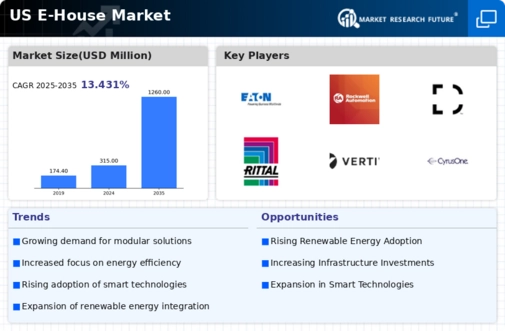The US E-House Market has been experiencing significant growth due to the increasing demand for modular power solutions and the transition towards sustainable energy sources. This market comprises various players that offer integrated electrical houses designed for efficient energy management and infrastructure support. The competitive landscape of this market is characterized by several key competitors who strive to enhance their product offerings through innovation, operational efficiencies, and strategic partnerships.
As businesses and utilities continue to seek out more reliable and flexible energy solutions, the competitive dynamics are continually evolving, leading to greater investments in technology, research and development, and customer engagement.
Companies are positioning themselves to capitalize on the growing need for E-Houses in various sectors, including renewable energy, utilities, and industrial applications.In the US E-House Market, Emerson Electric has distinguished itself with its strong portfolio of modular power solutions and its emphasis on innovative technologies. The company has maintained a solid presence in the market by offering advanced electrical distribution systems, intelligent control solutions, and integrated support services that address the specific needs of various industries. Emerson Electric's strengths lie in its long-standing expertise in automation and control, which enable it to provide efficient and reliable power solutions.
Additionally, the company invests heavily in research and development, allowing it to stay ahead of the curve in technological advancements and customer preferences. This commitment to innovation, combined with a focus on enhancing operational reliability, has established Emerson Electric as a key player within the competitive framework of the US E-House Market.ABB holds a prominent position in the US E-House Market, recognized for its extensive array of products and services that cater to electrical infrastructure and power management solutions.
The company offers customized E-House systems that integrate various components, such as switchgear, transformers, and monitoring technologies, providing comprehensive power solutions for industries, including oil and gas, mining, and renewables.
ABB's market presence is bolstered by strategic mergers and acquisitions that enhance its capabilities and market reach, allowing the company to deliver cutting-edge solutions that meet the evolving needs of its customers. The organization's strengths are rooted in its commitment to sustainability and efficiency, resulting in products that not only improve performance but also reduce environmental impact. Through continuous engagement with clients and a focus on innovation, ABB continues to fortify its position in the US E-House Market, reinforcing its reputation as a leader in this competitive landscape.




















